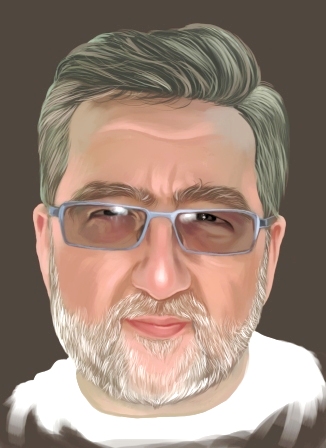 |

When I wrote my first Black Horse Western way back in 1984, I wanted
the villain, a half-breed Comanchero named Nathan Rocco, to meet a spectacular
end. All through the book he'd worn crossed bandoliers, and at the climax
of the story, the two heroes both shoot him at the same time. The bullets
strike the shotgun shells in the bandoliers, and Nathan Rocco more or
less explodes.
Some years later, when reviewing the book for the second edition of The
Encyclopaedia of Frontier and Western Fiction (a review, incidentally,
which was never actually used), Geoff Sadler commented that this particular
death was a little too over-the-top, and spoiled what was an otherwise
reasonable first effort.
Perhaps he was right (See Footnote 1, below). But then, the events and characters we portray
in fiction -- especially genre fiction -- have to be larger than
life, for one very simple reason. We read this type of fiction in order
to escape from the prosaic, humdrum predictability of everyday existence.
Reading about someone taking his dog for a walk, or mowing the lawn or
doing the washing-up, may be true to life, but it's never going to provide
the escapism we are almost guaranteed to get from a good old-fashioned
shoot-'em-up.
In any case, life is by and large a fairly ordinary affair, and -- perhaps
fortunately -- few of us ever get the chance to go out in a blaze of glory,
as do the characters we like to read and write about. Take Clay Allison,
for example. He may have been one of the Old West's most colourful characters,
but he met his end in a most undignified manner.
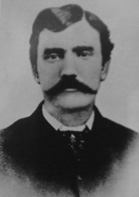
Returning home to his ranch one July night in 1887, Clay's wagon hit
a bump in the road. Already as drunk as the proverbial skunk, he fell
out of the wagon and rolled right into the path of its rear wheels. The
snap of his neck ended the career of a man said to have killed between
15 and 24 men.
Then there was the ambidextrous Jim Courtwright. Jim did
die in a gunfight -- killed in a shoot-out with Luke Short in 1887 --
but he didn't exactly go out with much dignity. Luke's first shot took
off Jim's right thumb, and before he could bring his left-hand gun into
play, Luke sealed his fate by ventilating him with another three slugs.
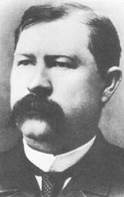
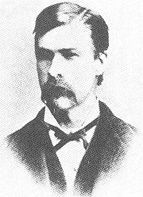
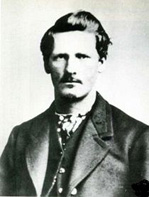
Then there were the Earp brothers. Virgil died in 1906,
but spent the last 25 years of his life crippled after being cut down
by five hidden shotguns on December 28th 1881. Morgan Earp was
playing pool one evening in March 1882 when a flurry of shots blasted
through a window and caught him in the back. He died aged 31.
As for Wyatt Earp himself, well, he must have had a charmed life,
because he died peacefully in 1929 at the grand old age of 80.

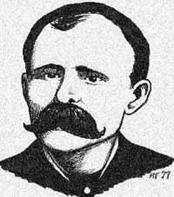
John "King" Fisher
was killed along with gunman Ben Thompson
in a San Antonio variety theatre on March 10th 1884. Ironically, there
was no grudge against Fisher. He just happened to be in the wrong place
at the wrong time, and was caught in the crossfire when friends of one
of Thompson's many victims gunned him down in revenge. Thompson was 42,
Fisher just 30.
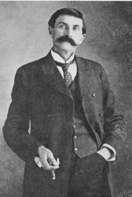
Pat Garrett
, the man who famously dispatched Billy the Kid, was
killed in what may or may not have been a gunfight. There had been a disagreement
between Pat and one of the tenants on his ranch. Pat was said to be reaching
for a shotgun when he caught some lead from Judge Colt. But will we ever
know the truth? He was shot through the chest -- and also the back of
the head. At the trial, his killer was acquitted. That was in 1908, the
year Pat turned 57.
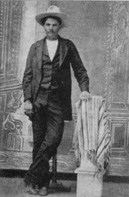
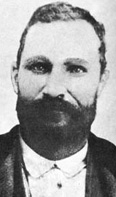
John Wesley Hardin
was one of the Old West's most famous characters.
He had around 40 killings to his credit when his turn finally came in
1895. But he didn't meet his end in a gunfight. Some say Wes was armed
that night, some say he wasn't. What really mattered was that lawman John
Selman shot him in the back. Hardin was 42.
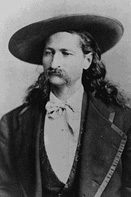
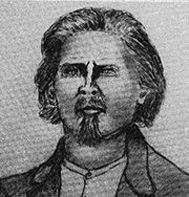
In 1876, James Butler "Wild Bill" Hickok was shot in the back
of the head by black-hearted Jack McCall. No gunfight -- just straight
murder. Wild Bill was 39.
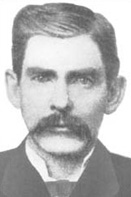
John Henry "Doc" Holliday
packed more than his share of living
into his brief 35 years. He died the victim of tuberculosis, but nobody
can say that he didn't die with his boots on -- even though he was in
a sanatorium bed at the time.
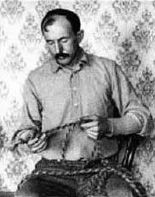
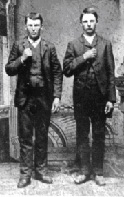
Tom Horn
wasn't so much a gunfighter as an out-and-out killer.
He was hanged in 1903, aged 42. And what about Frank and Jessie
James? Jesse was 34 years old when he stood on a chair to straighten
a picture on the wall -- and was shot in the back of the head by "dirty
little coward" Bob Ford. Frank, on the other hand, died of old age in
1915. He was 71.
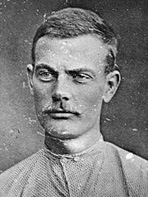
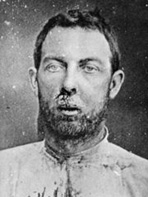
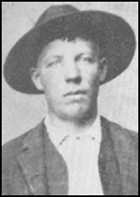
And what about the Younger boys, who accompanied Frank and Jesse
on so many raids? What kind of end did these miscreants meet?
Well, Robert Younger died of tuberculosis in Stillwater Penitentiary
in 1889, where he was serving a life sentence. Jim Younger committed
suicide in 1901, aged 53. And Cole Younger, the most famous of
the clan, died of old age in 1916, aged 72.
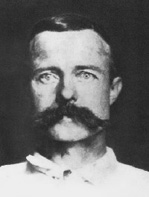
The cause of gunfighter "Buckskin" Frank Leslie's death was never
satisfactorily settled. It was said that he committed suicide in 1924
-- at the age of 82.
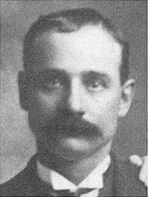
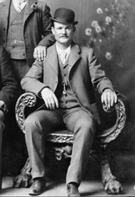
Likewise, historians have never been able to agree on the fate of Harvey
Logan, better-known as "Kid Curry." It's believed that he went
to South America with Butch Cassidy and the Sundance Kid.
Harry Longbaugh, alias Sundance, did go out in a blaze of glory.
Cornered by a group of Bolivian cavalrymen in 1907, he was cut down by
a score of rifles as he broke cover to get some more ammunition. His partner,
Robert Leroy Parker, alias Butch Cassidy, shot himself in the head rather
than face capture.
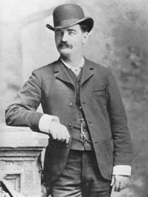
Bat Masterson
didn't kill as many people as legend now has it,
but he did deserve some of his notoriety. However, he died of natural
causes in 1921, aged 66. Lawman "Texas" John Slaughter also died
of old age, in 1922, aged 81.
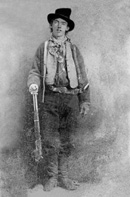
Henry McCarty, alias Billy Bonney, alias Billy the Kid, was only
21 when he was gunned down by Pat Garrett. This could hardly be described
as a gunfight, though. The action took place in a darkened room, and Billy
couldn't even see Pat to shoot back at him.
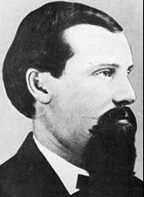
Henry Plummer
was one of the most famous gunmen in the west. He
was also a celebrated womaniser, drinker, crook and killer. In fact, he
seemed to excel at so much that it was almost a shame when he became the
guest of honour at a "necktie social" in 1864. He was just 27.
Of course, Warren Earp was killed in a gunfight with two
rustlers in 1900, and John Younger did die in a gunfight
with two lawman in 1874, at the age of 19. But for the most part, those
men who lived by the gun -- be it for good reasons or bad, or reasons
over which they had no control -- did not always cash in the way that
Hollywood -- or indeed writers like myself -- would have us believe.
In conclusion, then, it is certainly true that truth is often stranger
than fiction ... but rarely is it as colourful or downright dramatic!
(Footnote 1): Paddy Gallagher, better-known to BHW readers as Greg Mitchell, writes: "I was reading your piece on the fate of your villain Nathan Rocco. His ending was not as far-fetched as some would think. Here is a real life parallel.
My father was serving in the Australian Light Horse in Palestine in 1918. They wore a bandolier over the left shoulder and carried another around the horse's neck. If fighting dismounted, they often took the bandolier off the horse and wore them crossed. In a dismounted attack at a place clled Semakh. one sergeant had just put on the spare bandolier when a shot hit him right where the two bandoliers crossed. It exploded some of the cartridges but the steel clips and brass cartridge cases deflected what should have been a killing shot. The sergeant was wounded but lived. I am not sure if he was wounded by some of his own cartridges or how many were set off but they only fired single bullets. Your villain's shotgun cartridges would have scattered a lot more shot through him and the soft brass bases on the cartridges probably would not have deflected the bullet that caused the original damage. So truth can be as strange as fiction and Rocco's ending was not as way out as some would think!"
Some years later, when reviewing the book for the second edition of The
Encyclopaedia of Frontier and Western Fiction (a review, incidentally,
which was never actually used), Geoff Sadler commented that this particular
death was a little too over-the-top, and spoiled what was an otherwise
reasonable first effort.
Perhaps he was right (See Footnote 1, below). But then, the events and characters we portray
in fiction -- especially genre fiction -- have to be larger than
life, for one very simple reason. We read this type of fiction in order
to escape from the prosaic, humdrum predictability of everyday existence.
Reading about someone taking his dog for a walk, or mowing the lawn or
doing the washing-up, may be true to life, but it's never going to provide
the escapism we are almost guaranteed to get from a good old-fashioned
shoot-'em-up.
In any case, life is by and large a fairly ordinary affair, and -- perhaps
fortunately -- few of us ever get the chance to go out in a blaze of glory,
as do the characters we like to read and write about. Take Clay Allison,
for example. He may have been one of the Old West's most colourful characters,
but he met his end in a most undignified manner.

Returning home to his ranch one July night in 1887, Clay's wagon hit
a bump in the road. Already as drunk as the proverbial skunk, he fell
out of the wagon and rolled right into the path of its rear wheels. The
snap of his neck ended the career of a man said to have killed between
15 and 24 men.
Then there was the ambidextrous Jim Courtwright. Jim did
die in a gunfight -- killed in a shoot-out with Luke Short in 1887 --
but he didn't exactly go out with much dignity. Luke's first shot took
off Jim's right thumb, and before he could bring his left-hand gun into
play, Luke sealed his fate by ventilating him with another three slugs.



Then there were the Earp brothers. Virgil died in 1906,
but spent the last 25 years of his life crippled after being cut down
by five hidden shotguns on December 28th 1881. Morgan Earp was
playing pool one evening in March 1882 when a flurry of shots blasted
through a window and caught him in the back. He died aged 31.
As for Wyatt Earp himself, well, he must have had a charmed life,
because he died peacefully in 1929 at the grand old age of 80.


John "King" Fisher
was killed along with gunman Ben Thompson
in a San Antonio variety theatre on March 10th 1884. Ironically, there
was no grudge against Fisher. He just happened to be in the wrong place
at the wrong time, and was caught in the crossfire when friends of one
of Thompson's many victims gunned him down in revenge. Thompson was 42,
Fisher just 30.

Pat Garrett
, the man who famously dispatched Billy the Kid, was
killed in what may or may not have been a gunfight. There had been a disagreement
between Pat and one of the tenants on his ranch. Pat was said to be reaching
for a shotgun when he caught some lead from Judge Colt. But will we ever
know the truth? He was shot through the chest -- and also the back of
the head. At the trial, his killer was acquitted. That was in 1908, the
year Pat turned 57.


John Wesley Hardin
was one of the Old West's most famous characters.
He had around 40 killings to his credit when his turn finally came in
1895. But he didn't meet his end in a gunfight. Some say Wes was armed
that night, some say he wasn't. What really mattered was that lawman John
Selman shot him in the back. Hardin was 42.


In 1876, James Butler "Wild Bill" Hickok was shot in the back
of the head by black-hearted Jack McCall. No gunfight -- just straight
murder. Wild Bill was 39.

John Henry "Doc" Holliday
packed more than his share of living
into his brief 35 years. He died the victim of tuberculosis, but nobody
can say that he didn't die with his boots on -- even though he was in
a sanatorium bed at the time.


Tom Horn
wasn't so much a gunfighter as an out-and-out killer.
He was hanged in 1903, aged 42. And what about Frank and Jessie
James? Jesse was 34 years old when he stood on a chair to straighten
a picture on the wall -- and was shot in the back of the head by "dirty
little coward" Bob Ford. Frank, on the other hand, died of old age in
1915. He was 71.



And what about the Younger boys, who accompanied Frank and Jesse
on so many raids? What kind of end did these miscreants meet?
Well, Robert Younger died of tuberculosis in Stillwater Penitentiary
in 1889, where he was serving a life sentence. Jim Younger committed
suicide in 1901, aged 53. And Cole Younger, the most famous of
the clan, died of old age in 1916, aged 72.

The cause of gunfighter "Buckskin" Frank Leslie's death was never
satisfactorily settled. It was said that he committed suicide in 1924
-- at the age of 82.


Likewise, historians have never been able to agree on the fate of Harvey
Logan, better-known as "Kid Curry." It's believed that he went
to South America with Butch Cassidy and the Sundance Kid.
Harry Longbaugh, alias Sundance, did go out in a blaze of glory.
Cornered by a group of Bolivian cavalrymen in 1907, he was cut down by
a score of rifles as he broke cover to get some more ammunition. His partner,
Robert Leroy Parker, alias Butch Cassidy, shot himself in the head rather
than face capture.

Bat Masterson
didn't kill as many people as legend now has it,
but he did deserve some of his notoriety. However, he died of natural
causes in 1921, aged 66. Lawman "Texas" John Slaughter also died
of old age, in 1922, aged 81.

Henry McCarty, alias Billy Bonney, alias Billy the Kid, was only
21 when he was gunned down by Pat Garrett. This could hardly be described
as a gunfight, though. The action took place in a darkened room, and Billy
couldn't even see Pat to shoot back at him.

Henry Plummer
was one of the most famous gunmen in the west. He
was also a celebrated womaniser, drinker, crook and killer. In fact, he
seemed to excel at so much that it was almost a shame when he became the
guest of honour at a "necktie social" in 1864. He was just 27.
Of course, Warren Earp was killed in a gunfight with two
rustlers in 1900, and John Younger did die in a gunfight
with two lawman in 1874, at the age of 19. But for the most part, those
men who lived by the gun -- be it for good reasons or bad, or reasons
over which they had no control -- did not always cash in the way that
Hollywood -- or indeed writers like myself -- would have us believe.
In conclusion, then, it is certainly true that truth is often stranger
than fiction ... but rarely is it as colourful or downright dramatic!
(Footnote 1): Paddy Gallagher, better-known to BHW readers as Greg Mitchell, writes: "I was reading your piece on the fate of your villain Nathan Rocco. His ending was not as far-fetched as some would think. Here is a real life parallel.
My father was serving in the Australian Light Horse in Palestine in 1918. They wore a bandolier over the left shoulder and carried another around the horse's neck. If fighting dismounted, they often took the bandolier off the horse and wore them crossed. In a dismounted attack at a place clled Semakh. one sergeant had just put on the spare bandolier when a shot hit him right where the two bandoliers crossed. It exploded some of the cartridges but the steel clips and brass cartridge cases deflected what should have been a killing shot. The sergeant was wounded but lived. I am not sure if he was wounded by some of his own cartridges or how many were set off but they only fired single bullets. Your villain's shotgun cartridges would have scattered a lot more shot through him and the soft brass bases on the cartridges probably would not have deflected the bullet that caused the original damage. So truth can be as strange as fiction and Rocco's ending was not as way out as some would think!"
Perhaps he was right (See Footnote 1, below). But then, the events and characters we portray
in fiction -- especially genre fiction -- have to be larger than
life, for one very simple reason. We read this type of fiction in order
to escape from the prosaic, humdrum predictability of everyday existence.
Reading about someone taking his dog for a walk, or mowing the lawn or
doing the washing-up, may be true to life, but it's never going to provide
the escapism we are almost guaranteed to get from a good old-fashioned
shoot-'em-up.
In any case, life is by and large a fairly ordinary affair, and -- perhaps
fortunately -- few of us ever get the chance to go out in a blaze of glory,
as do the characters we like to read and write about. Take Clay Allison,
for example. He may have been one of the Old West's most colourful characters,
but he met his end in a most undignified manner.

Returning home to his ranch one July night in 1887, Clay's wagon hit
a bump in the road. Already as drunk as the proverbial skunk, he fell
out of the wagon and rolled right into the path of its rear wheels. The
snap of his neck ended the career of a man said to have killed between
15 and 24 men.
Then there was the ambidextrous Jim Courtwright. Jim did
die in a gunfight -- killed in a shoot-out with Luke Short in 1887 --
but he didn't exactly go out with much dignity. Luke's first shot took
off Jim's right thumb, and before he could bring his left-hand gun into
play, Luke sealed his fate by ventilating him with another three slugs.



Then there were the Earp brothers. Virgil died in 1906,
but spent the last 25 years of his life crippled after being cut down
by five hidden shotguns on December 28th 1881. Morgan Earp was
playing pool one evening in March 1882 when a flurry of shots blasted
through a window and caught him in the back. He died aged 31.
As for Wyatt Earp himself, well, he must have had a charmed life,
because he died peacefully in 1929 at the grand old age of 80.


John "King" Fisher
was killed along with gunman Ben Thompson
in a San Antonio variety theatre on March 10th 1884. Ironically, there
was no grudge against Fisher. He just happened to be in the wrong place
at the wrong time, and was caught in the crossfire when friends of one
of Thompson's many victims gunned him down in revenge. Thompson was 42,
Fisher just 30.

Pat Garrett
, the man who famously dispatched Billy the Kid, was
killed in what may or may not have been a gunfight. There had been a disagreement
between Pat and one of the tenants on his ranch. Pat was said to be reaching
for a shotgun when he caught some lead from Judge Colt. But will we ever
know the truth? He was shot through the chest -- and also the back of
the head. At the trial, his killer was acquitted. That was in 1908, the
year Pat turned 57.


John Wesley Hardin
was one of the Old West's most famous characters.
He had around 40 killings to his credit when his turn finally came in
1895. But he didn't meet his end in a gunfight. Some say Wes was armed
that night, some say he wasn't. What really mattered was that lawman John
Selman shot him in the back. Hardin was 42.


In 1876, James Butler "Wild Bill" Hickok was shot in the back
of the head by black-hearted Jack McCall. No gunfight -- just straight
murder. Wild Bill was 39.

John Henry "Doc" Holliday
packed more than his share of living
into his brief 35 years. He died the victim of tuberculosis, but nobody
can say that he didn't die with his boots on -- even though he was in
a sanatorium bed at the time.


Tom Horn
wasn't so much a gunfighter as an out-and-out killer.
He was hanged in 1903, aged 42. And what about Frank and Jessie
James? Jesse was 34 years old when he stood on a chair to straighten
a picture on the wall -- and was shot in the back of the head by "dirty
little coward" Bob Ford. Frank, on the other hand, died of old age in
1915. He was 71.



And what about the Younger boys, who accompanied Frank and Jesse
on so many raids? What kind of end did these miscreants meet?
Well, Robert Younger died of tuberculosis in Stillwater Penitentiary
in 1889, where he was serving a life sentence. Jim Younger committed
suicide in 1901, aged 53. And Cole Younger, the most famous of
the clan, died of old age in 1916, aged 72.

The cause of gunfighter "Buckskin" Frank Leslie's death was never
satisfactorily settled. It was said that he committed suicide in 1924
-- at the age of 82.


Likewise, historians have never been able to agree on the fate of Harvey
Logan, better-known as "Kid Curry." It's believed that he went
to South America with Butch Cassidy and the Sundance Kid.
Harry Longbaugh, alias Sundance, did go out in a blaze of glory.
Cornered by a group of Bolivian cavalrymen in 1907, he was cut down by
a score of rifles as he broke cover to get some more ammunition. His partner,
Robert Leroy Parker, alias Butch Cassidy, shot himself in the head rather
than face capture.

Bat Masterson
didn't kill as many people as legend now has it,
but he did deserve some of his notoriety. However, he died of natural
causes in 1921, aged 66. Lawman "Texas" John Slaughter also died
of old age, in 1922, aged 81.

Henry McCarty, alias Billy Bonney, alias Billy the Kid, was only
21 when he was gunned down by Pat Garrett. This could hardly be described
as a gunfight, though. The action took place in a darkened room, and Billy
couldn't even see Pat to shoot back at him.

Henry Plummer
was one of the most famous gunmen in the west. He
was also a celebrated womaniser, drinker, crook and killer. In fact, he
seemed to excel at so much that it was almost a shame when he became the
guest of honour at a "necktie social" in 1864. He was just 27.
Of course, Warren Earp was killed in a gunfight with two
rustlers in 1900, and John Younger did die in a gunfight
with two lawman in 1874, at the age of 19. But for the most part, those
men who lived by the gun -- be it for good reasons or bad, or reasons
over which they had no control -- did not always cash in the way that
Hollywood -- or indeed writers like myself -- would have us believe.
In conclusion, then, it is certainly true that truth is often stranger
than fiction ... but rarely is it as colourful or downright dramatic!
(Footnote 1): Paddy Gallagher, better-known to BHW readers as Greg Mitchell, writes: "I was reading your piece on the fate of your villain Nathan Rocco. His ending was not as far-fetched as some would think. Here is a real life parallel.
My father was serving in the Australian Light Horse in Palestine in 1918. They wore a bandolier over the left shoulder and carried another around the horse's neck. If fighting dismounted, they often took the bandolier off the horse and wore them crossed. In a dismounted attack at a place clled Semakh. one sergeant had just put on the spare bandolier when a shot hit him right where the two bandoliers crossed. It exploded some of the cartridges but the steel clips and brass cartridge cases deflected what should have been a killing shot. The sergeant was wounded but lived. I am not sure if he was wounded by some of his own cartridges or how many were set off but they only fired single bullets. Your villain's shotgun cartridges would have scattered a lot more shot through him and the soft brass bases on the cartridges probably would not have deflected the bullet that caused the original damage. So truth can be as strange as fiction and Rocco's ending was not as way out as some would think!"
In any case, life is by and large a fairly ordinary affair, and -- perhaps
fortunately -- few of us ever get the chance to go out in a blaze of glory,
as do the characters we like to read and write about. Take Clay Allison,
for example. He may have been one of the Old West's most colourful characters,
but he met his end in a most undignified manner.

Returning home to his ranch one July night in 1887, Clay's wagon hit
a bump in the road. Already as drunk as the proverbial skunk, he fell
out of the wagon and rolled right into the path of its rear wheels. The
snap of his neck ended the career of a man said to have killed between
15 and 24 men.
Then there was the ambidextrous Jim Courtwright. Jim did
die in a gunfight -- killed in a shoot-out with Luke Short in 1887 --
but he didn't exactly go out with much dignity. Luke's first shot took
off Jim's right thumb, and before he could bring his left-hand gun into
play, Luke sealed his fate by ventilating him with another three slugs.



Then there were the Earp brothers. Virgil died in 1906,
but spent the last 25 years of his life crippled after being cut down
by five hidden shotguns on December 28th 1881. Morgan Earp was
playing pool one evening in March 1882 when a flurry of shots blasted
through a window and caught him in the back. He died aged 31.
As for Wyatt Earp himself, well, he must have had a charmed life,
because he died peacefully in 1929 at the grand old age of 80.


John "King" Fisher
was killed along with gunman Ben Thompson
in a San Antonio variety theatre on March 10th 1884. Ironically, there
was no grudge against Fisher. He just happened to be in the wrong place
at the wrong time, and was caught in the crossfire when friends of one
of Thompson's many victims gunned him down in revenge. Thompson was 42,
Fisher just 30.

Pat Garrett
, the man who famously dispatched Billy the Kid, was
killed in what may or may not have been a gunfight. There had been a disagreement
between Pat and one of the tenants on his ranch. Pat was said to be reaching
for a shotgun when he caught some lead from Judge Colt. But will we ever
know the truth? He was shot through the chest -- and also the back of
the head. At the trial, his killer was acquitted. That was in 1908, the
year Pat turned 57.


John Wesley Hardin
was one of the Old West's most famous characters.
He had around 40 killings to his credit when his turn finally came in
1895. But he didn't meet his end in a gunfight. Some say Wes was armed
that night, some say he wasn't. What really mattered was that lawman John
Selman shot him in the back. Hardin was 42.


In 1876, James Butler "Wild Bill" Hickok was shot in the back
of the head by black-hearted Jack McCall. No gunfight -- just straight
murder. Wild Bill was 39.

John Henry "Doc" Holliday
packed more than his share of living
into his brief 35 years. He died the victim of tuberculosis, but nobody
can say that he didn't die with his boots on -- even though he was in
a sanatorium bed at the time.


Tom Horn
wasn't so much a gunfighter as an out-and-out killer.
He was hanged in 1903, aged 42. And what about Frank and Jessie
James? Jesse was 34 years old when he stood on a chair to straighten
a picture on the wall -- and was shot in the back of the head by "dirty
little coward" Bob Ford. Frank, on the other hand, died of old age in
1915. He was 71.



And what about the Younger boys, who accompanied Frank and Jesse
on so many raids? What kind of end did these miscreants meet?
Well, Robert Younger died of tuberculosis in Stillwater Penitentiary
in 1889, where he was serving a life sentence. Jim Younger committed
suicide in 1901, aged 53. And Cole Younger, the most famous of
the clan, died of old age in 1916, aged 72.

The cause of gunfighter "Buckskin" Frank Leslie's death was never
satisfactorily settled. It was said that he committed suicide in 1924
-- at the age of 82.


Likewise, historians have never been able to agree on the fate of Harvey
Logan, better-known as "Kid Curry." It's believed that he went
to South America with Butch Cassidy and the Sundance Kid.
Harry Longbaugh, alias Sundance, did go out in a blaze of glory.
Cornered by a group of Bolivian cavalrymen in 1907, he was cut down by
a score of rifles as he broke cover to get some more ammunition. His partner,
Robert Leroy Parker, alias Butch Cassidy, shot himself in the head rather
than face capture.

Bat Masterson
didn't kill as many people as legend now has it,
but he did deserve some of his notoriety. However, he died of natural
causes in 1921, aged 66. Lawman "Texas" John Slaughter also died
of old age, in 1922, aged 81.

Henry McCarty, alias Billy Bonney, alias Billy the Kid, was only
21 when he was gunned down by Pat Garrett. This could hardly be described
as a gunfight, though. The action took place in a darkened room, and Billy
couldn't even see Pat to shoot back at him.

Henry Plummer
was one of the most famous gunmen in the west. He
was also a celebrated womaniser, drinker, crook and killer. In fact, he
seemed to excel at so much that it was almost a shame when he became the
guest of honour at a "necktie social" in 1864. He was just 27.
Of course, Warren Earp was killed in a gunfight with two
rustlers in 1900, and John Younger did die in a gunfight
with two lawman in 1874, at the age of 19. But for the most part, those
men who lived by the gun -- be it for good reasons or bad, or reasons
over which they had no control -- did not always cash in the way that
Hollywood -- or indeed writers like myself -- would have us believe.
In conclusion, then, it is certainly true that truth is often stranger
than fiction ... but rarely is it as colourful or downright dramatic!
(Footnote 1): Paddy Gallagher, better-known to BHW readers as Greg Mitchell, writes: "I was reading your piece on the fate of your villain Nathan Rocco. His ending was not as far-fetched as some would think. Here is a real life parallel.
My father was serving in the Australian Light Horse in Palestine in 1918. They wore a bandolier over the left shoulder and carried another around the horse's neck. If fighting dismounted, they often took the bandolier off the horse and wore them crossed. In a dismounted attack at a place clled Semakh. one sergeant had just put on the spare bandolier when a shot hit him right where the two bandoliers crossed. It exploded some of the cartridges but the steel clips and brass cartridge cases deflected what should have been a killing shot. The sergeant was wounded but lived. I am not sure if he was wounded by some of his own cartridges or how many were set off but they only fired single bullets. Your villain's shotgun cartridges would have scattered a lot more shot through him and the soft brass bases on the cartridges probably would not have deflected the bullet that caused the original damage. So truth can be as strange as fiction and Rocco's ending was not as way out as some would think!"

Returning home to his ranch one July night in 1887, Clay's wagon hit
a bump in the road. Already as drunk as the proverbial skunk, he fell
out of the wagon and rolled right into the path of its rear wheels. The
snap of his neck ended the career of a man said to have killed between
15 and 24 men.
Then there was the ambidextrous Jim Courtwright. Jim did
die in a gunfight -- killed in a shoot-out with Luke Short in 1887 --
but he didn't exactly go out with much dignity. Luke's first shot took
off Jim's right thumb, and before he could bring his left-hand gun into
play, Luke sealed his fate by ventilating him with another three slugs.



Then there were the Earp brothers. Virgil died in 1906,
but spent the last 25 years of his life crippled after being cut down
by five hidden shotguns on December 28th 1881. Morgan Earp was
playing pool one evening in March 1882 when a flurry of shots blasted
through a window and caught him in the back. He died aged 31.
As for Wyatt Earp himself, well, he must have had a charmed life,
because he died peacefully in 1929 at the grand old age of 80.


John "King" Fisher
was killed along with gunman Ben Thompson
in a San Antonio variety theatre on March 10th 1884. Ironically, there
was no grudge against Fisher. He just happened to be in the wrong place
at the wrong time, and was caught in the crossfire when friends of one
of Thompson's many victims gunned him down in revenge. Thompson was 42,
Fisher just 30.

Pat Garrett
, the man who famously dispatched Billy the Kid, was
killed in what may or may not have been a gunfight. There had been a disagreement
between Pat and one of the tenants on his ranch. Pat was said to be reaching
for a shotgun when he caught some lead from Judge Colt. But will we ever
know the truth? He was shot through the chest -- and also the back of
the head. At the trial, his killer was acquitted. That was in 1908, the
year Pat turned 57.


John Wesley Hardin
was one of the Old West's most famous characters.
He had around 40 killings to his credit when his turn finally came in
1895. But he didn't meet his end in a gunfight. Some say Wes was armed
that night, some say he wasn't. What really mattered was that lawman John
Selman shot him in the back. Hardin was 42.


In 1876, James Butler "Wild Bill" Hickok was shot in the back
of the head by black-hearted Jack McCall. No gunfight -- just straight
murder. Wild Bill was 39.

John Henry "Doc" Holliday
packed more than his share of living
into his brief 35 years. He died the victim of tuberculosis, but nobody
can say that he didn't die with his boots on -- even though he was in
a sanatorium bed at the time.


Tom Horn
wasn't so much a gunfighter as an out-and-out killer.
He was hanged in 1903, aged 42. And what about Frank and Jessie
James? Jesse was 34 years old when he stood on a chair to straighten
a picture on the wall -- and was shot in the back of the head by "dirty
little coward" Bob Ford. Frank, on the other hand, died of old age in
1915. He was 71.



And what about the Younger boys, who accompanied Frank and Jesse
on so many raids? What kind of end did these miscreants meet?
Well, Robert Younger died of tuberculosis in Stillwater Penitentiary
in 1889, where he was serving a life sentence. Jim Younger committed
suicide in 1901, aged 53. And Cole Younger, the most famous of
the clan, died of old age in 1916, aged 72.

The cause of gunfighter "Buckskin" Frank Leslie's death was never
satisfactorily settled. It was said that he committed suicide in 1924
-- at the age of 82.


Likewise, historians have never been able to agree on the fate of Harvey
Logan, better-known as "Kid Curry." It's believed that he went
to South America with Butch Cassidy and the Sundance Kid.
Harry Longbaugh, alias Sundance, did go out in a blaze of glory.
Cornered by a group of Bolivian cavalrymen in 1907, he was cut down by
a score of rifles as he broke cover to get some more ammunition. His partner,
Robert Leroy Parker, alias Butch Cassidy, shot himself in the head rather
than face capture.

Bat Masterson
didn't kill as many people as legend now has it,
but he did deserve some of his notoriety. However, he died of natural
causes in 1921, aged 66. Lawman "Texas" John Slaughter also died
of old age, in 1922, aged 81.

Henry McCarty, alias Billy Bonney, alias Billy the Kid, was only
21 when he was gunned down by Pat Garrett. This could hardly be described
as a gunfight, though. The action took place in a darkened room, and Billy
couldn't even see Pat to shoot back at him.

Henry Plummer
was one of the most famous gunmen in the west. He
was also a celebrated womaniser, drinker, crook and killer. In fact, he
seemed to excel at so much that it was almost a shame when he became the
guest of honour at a "necktie social" in 1864. He was just 27.
Of course, Warren Earp was killed in a gunfight with two
rustlers in 1900, and John Younger did die in a gunfight
with two lawman in 1874, at the age of 19. But for the most part, those
men who lived by the gun -- be it for good reasons or bad, or reasons
over which they had no control -- did not always cash in the way that
Hollywood -- or indeed writers like myself -- would have us believe.
In conclusion, then, it is certainly true that truth is often stranger
than fiction ... but rarely is it as colourful or downright dramatic!
(Footnote 1): Paddy Gallagher, better-known to BHW readers as Greg Mitchell, writes: "I was reading your piece on the fate of your villain Nathan Rocco. His ending was not as far-fetched as some would think. Here is a real life parallel.
My father was serving in the Australian Light Horse in Palestine in 1918. They wore a bandolier over the left shoulder and carried another around the horse's neck. If fighting dismounted, they often took the bandolier off the horse and wore them crossed. In a dismounted attack at a place clled Semakh. one sergeant had just put on the spare bandolier when a shot hit him right where the two bandoliers crossed. It exploded some of the cartridges but the steel clips and brass cartridge cases deflected what should have been a killing shot. The sergeant was wounded but lived. I am not sure if he was wounded by some of his own cartridges or how many were set off but they only fired single bullets. Your villain's shotgun cartridges would have scattered a lot more shot through him and the soft brass bases on the cartridges probably would not have deflected the bullet that caused the original damage. So truth can be as strange as fiction and Rocco's ending was not as way out as some would think!"
Then there was the ambidextrous Jim Courtwright. Jim did die in a gunfight -- killed in a shoot-out with Luke Short in 1887 -- but he didn't exactly go out with much dignity. Luke's first shot took off Jim's right thumb, and before he could bring his left-hand gun into play, Luke sealed his fate by ventilating him with another three slugs.
 |
 |
 |
Then there were the Earp brothers. Virgil died in 1906, but spent the last 25 years of his life crippled after being cut down by five hidden shotguns on December 28th 1881. Morgan Earp was playing pool one evening in March 1882 when a flurry of shots blasted through a window and caught him in the back. He died aged 31.
As for Wyatt Earp himself, well, he must have had a charmed life, because he died peacefully in 1929 at the grand old age of 80.
 |
 |
John "King" Fisher
was killed along with gunman Ben Thompson in a San Antonio variety theatre on March 10th 1884. Ironically, there was no grudge against Fisher. He just happened to be in the wrong place at the wrong time, and was caught in the crossfire when friends of one of Thompson's many victims gunned him down in revenge. Thompson was 42, Fisher just 30.
Pat Garrett
, the man who famously dispatched Billy the Kid, was killed in what may or may not have been a gunfight. There had been a disagreement between Pat and one of the tenants on his ranch. Pat was said to be reaching for a shotgun when he caught some lead from Judge Colt. But will we ever know the truth? He was shot through the chest -- and also the back of the head. At the trial, his killer was acquitted. That was in 1908, the year Pat turned 57. |
 |
John Wesley Hardin
was one of the Old West's most famous characters. He had around 40 killings to his credit when his turn finally came in 1895. But he didn't meet his end in a gunfight. Some say Wes was armed that night, some say he wasn't. What really mattered was that lawman John Selman shot him in the back. Hardin was 42. |
 |
In 1876, James Butler "Wild Bill" Hickok was shot in the back
of the head by black-hearted Jack McCall. No gunfight -- just straight
murder. Wild Bill was 39.

John Henry "Doc" Holliday
packed more than his share of living
into his brief 35 years. He died the victim of tuberculosis, but nobody
can say that he didn't die with his boots on -- even though he was in
a sanatorium bed at the time.


Tom Horn
wasn't so much a gunfighter as an out-and-out killer.
He was hanged in 1903, aged 42. And what about Frank and Jessie
James? Jesse was 34 years old when he stood on a chair to straighten
a picture on the wall -- and was shot in the back of the head by "dirty
little coward" Bob Ford. Frank, on the other hand, died of old age in
1915. He was 71.



And what about the Younger boys, who accompanied Frank and Jesse
on so many raids? What kind of end did these miscreants meet?
Well, Robert Younger died of tuberculosis in Stillwater Penitentiary
in 1889, where he was serving a life sentence. Jim Younger committed
suicide in 1901, aged 53. And Cole Younger, the most famous of
the clan, died of old age in 1916, aged 72.

The cause of gunfighter "Buckskin" Frank Leslie's death was never
satisfactorily settled. It was said that he committed suicide in 1924
-- at the age of 82.


Likewise, historians have never been able to agree on the fate of Harvey
Logan, better-known as "Kid Curry." It's believed that he went
to South America with Butch Cassidy and the Sundance Kid.
Harry Longbaugh, alias Sundance, did go out in a blaze of glory.
Cornered by a group of Bolivian cavalrymen in 1907, he was cut down by
a score of rifles as he broke cover to get some more ammunition. His partner,
Robert Leroy Parker, alias Butch Cassidy, shot himself in the head rather
than face capture.

Bat Masterson
didn't kill as many people as legend now has it,
but he did deserve some of his notoriety. However, he died of natural
causes in 1921, aged 66. Lawman "Texas" John Slaughter also died
of old age, in 1922, aged 81.

Henry McCarty, alias Billy Bonney, alias Billy the Kid, was only
21 when he was gunned down by Pat Garrett. This could hardly be described
as a gunfight, though. The action took place in a darkened room, and Billy
couldn't even see Pat to shoot back at him.

Henry Plummer
was one of the most famous gunmen in the west. He
was also a celebrated womaniser, drinker, crook and killer. In fact, he
seemed to excel at so much that it was almost a shame when he became the
guest of honour at a "necktie social" in 1864. He was just 27.
Of course, Warren Earp was killed in a gunfight with two
rustlers in 1900, and John Younger did die in a gunfight
with two lawman in 1874, at the age of 19. But for the most part, those
men who lived by the gun -- be it for good reasons or bad, or reasons
over which they had no control -- did not always cash in the way that
Hollywood -- or indeed writers like myself -- would have us believe.
In conclusion, then, it is certainly true that truth is often stranger
than fiction ... but rarely is it as colourful or downright dramatic!
(Footnote 1): Paddy Gallagher, better-known to BHW readers as Greg Mitchell, writes: "I was reading your piece on the fate of your villain Nathan Rocco. His ending was not as far-fetched as some would think. Here is a real life parallel.
My father was serving in the Australian Light Horse in Palestine in 1918. They wore a bandolier over the left shoulder and carried another around the horse's neck. If fighting dismounted, they often took the bandolier off the horse and wore them crossed. In a dismounted attack at a place clled Semakh. one sergeant had just put on the spare bandolier when a shot hit him right where the two bandoliers crossed. It exploded some of the cartridges but the steel clips and brass cartridge cases deflected what should have been a killing shot. The sergeant was wounded but lived. I am not sure if he was wounded by some of his own cartridges or how many were set off but they only fired single bullets. Your villain's shotgun cartridges would have scattered a lot more shot through him and the soft brass bases on the cartridges probably would not have deflected the bullet that caused the original damage. So truth can be as strange as fiction and Rocco's ending was not as way out as some would think!"

John Henry "Doc" Holliday
packed more than his share of living into his brief 35 years. He died the victim of tuberculosis, but nobody can say that he didn't die with his boots on -- even though he was in a sanatorium bed at the time. |
 |
Tom Horn
wasn't so much a gunfighter as an out-and-out killer.
He was hanged in 1903, aged 42. And what about Frank and Jessie
James? Jesse was 34 years old when he stood on a chair to straighten
a picture on the wall -- and was shot in the back of the head by "dirty
little coward" Bob Ford. Frank, on the other hand, died of old age in
1915. He was 71.
 |
 |
 |
And what about the Younger boys, who accompanied Frank and Jesse on so many raids? What kind of end did these miscreants meet?
Well, Robert Younger died of tuberculosis in Stillwater Penitentiary
in 1889, where he was serving a life sentence. Jim Younger committed
suicide in 1901, aged 53. And Cole Younger, the most famous of
the clan, died of old age in 1916, aged 72.

The cause of gunfighter "Buckskin" Frank Leslie's death was never
satisfactorily settled. It was said that he committed suicide in 1924
-- at the age of 82.


Likewise, historians have never been able to agree on the fate of Harvey
Logan, better-known as "Kid Curry." It's believed that he went
to South America with Butch Cassidy and the Sundance Kid.
Harry Longbaugh, alias Sundance, did go out in a blaze of glory.
Cornered by a group of Bolivian cavalrymen in 1907, he was cut down by
a score of rifles as he broke cover to get some more ammunition. His partner,
Robert Leroy Parker, alias Butch Cassidy, shot himself in the head rather
than face capture.

Bat Masterson
didn't kill as many people as legend now has it,
but he did deserve some of his notoriety. However, he died of natural
causes in 1921, aged 66. Lawman "Texas" John Slaughter also died
of old age, in 1922, aged 81.

Henry McCarty, alias Billy Bonney, alias Billy the Kid, was only
21 when he was gunned down by Pat Garrett. This could hardly be described
as a gunfight, though. The action took place in a darkened room, and Billy
couldn't even see Pat to shoot back at him.

Henry Plummer
was one of the most famous gunmen in the west. He
was also a celebrated womaniser, drinker, crook and killer. In fact, he
seemed to excel at so much that it was almost a shame when he became the
guest of honour at a "necktie social" in 1864. He was just 27.
Of course, Warren Earp was killed in a gunfight with two
rustlers in 1900, and John Younger did die in a gunfight
with two lawman in 1874, at the age of 19. But for the most part, those
men who lived by the gun -- be it for good reasons or bad, or reasons
over which they had no control -- did not always cash in the way that
Hollywood -- or indeed writers like myself -- would have us believe.
In conclusion, then, it is certainly true that truth is often stranger
than fiction ... but rarely is it as colourful or downright dramatic!
(Footnote 1): Paddy Gallagher, better-known to BHW readers as Greg Mitchell, writes: "I was reading your piece on the fate of your villain Nathan Rocco. His ending was not as far-fetched as some would think. Here is a real life parallel.
My father was serving in the Australian Light Horse in Palestine in 1918. They wore a bandolier over the left shoulder and carried another around the horse's neck. If fighting dismounted, they often took the bandolier off the horse and wore them crossed. In a dismounted attack at a place clled Semakh. one sergeant had just put on the spare bandolier when a shot hit him right where the two bandoliers crossed. It exploded some of the cartridges but the steel clips and brass cartridge cases deflected what should have been a killing shot. The sergeant was wounded but lived. I am not sure if he was wounded by some of his own cartridges or how many were set off but they only fired single bullets. Your villain's shotgun cartridges would have scattered a lot more shot through him and the soft brass bases on the cartridges probably would not have deflected the bullet that caused the original damage. So truth can be as strange as fiction and Rocco's ending was not as way out as some would think!"

The cause of gunfighter "Buckskin" Frank Leslie's death was never satisfactorily settled. It was said that he committed suicide in 1924 -- at the age of 82.
 |
 |
Likewise, historians have never been able to agree on the fate of Harvey
Logan, better-known as "Kid Curry." It's believed that he went
to South America with Butch Cassidy and the Sundance Kid.
Harry Longbaugh, alias Sundance, did go out in a blaze of glory.
Cornered by a group of Bolivian cavalrymen in 1907, he was cut down by
a score of rifles as he broke cover to get some more ammunition. His partner,
Robert Leroy Parker, alias Butch Cassidy, shot himself in the head rather
than face capture.

Bat Masterson
didn't kill as many people as legend now has it,
but he did deserve some of his notoriety. However, he died of natural
causes in 1921, aged 66. Lawman "Texas" John Slaughter also died
of old age, in 1922, aged 81.

Henry McCarty, alias Billy Bonney, alias Billy the Kid, was only
21 when he was gunned down by Pat Garrett. This could hardly be described
as a gunfight, though. The action took place in a darkened room, and Billy
couldn't even see Pat to shoot back at him.

Henry Plummer
was one of the most famous gunmen in the west. He
was also a celebrated womaniser, drinker, crook and killer. In fact, he
seemed to excel at so much that it was almost a shame when he became the
guest of honour at a "necktie social" in 1864. He was just 27.
Of course, Warren Earp was killed in a gunfight with two
rustlers in 1900, and John Younger did die in a gunfight
with two lawman in 1874, at the age of 19. But for the most part, those
men who lived by the gun -- be it for good reasons or bad, or reasons
over which they had no control -- did not always cash in the way that
Hollywood -- or indeed writers like myself -- would have us believe.
In conclusion, then, it is certainly true that truth is often stranger
than fiction ... but rarely is it as colourful or downright dramatic!
(Footnote 1): Paddy Gallagher, better-known to BHW readers as Greg Mitchell, writes: "I was reading your piece on the fate of your villain Nathan Rocco. His ending was not as far-fetched as some would think. Here is a real life parallel.
My father was serving in the Australian Light Horse in Palestine in 1918. They wore a bandolier over the left shoulder and carried another around the horse's neck. If fighting dismounted, they often took the bandolier off the horse and wore them crossed. In a dismounted attack at a place clled Semakh. one sergeant had just put on the spare bandolier when a shot hit him right where the two bandoliers crossed. It exploded some of the cartridges but the steel clips and brass cartridge cases deflected what should have been a killing shot. The sergeant was wounded but lived. I am not sure if he was wounded by some of his own cartridges or how many were set off but they only fired single bullets. Your villain's shotgun cartridges would have scattered a lot more shot through him and the soft brass bases on the cartridges probably would not have deflected the bullet that caused the original damage. So truth can be as strange as fiction and Rocco's ending was not as way out as some would think!"

Bat Masterson
didn't kill as many people as legend now has it,
but he did deserve some of his notoriety. However, he died of natural
causes in 1921, aged 66. Lawman "Texas" John Slaughter also died
of old age, in 1922, aged 81.

Henry McCarty, alias Billy Bonney, alias Billy the Kid, was only
21 when he was gunned down by Pat Garrett. This could hardly be described
as a gunfight, though. The action took place in a darkened room, and Billy
couldn't even see Pat to shoot back at him.

Henry Plummer
was one of the most famous gunmen in the west. He
was also a celebrated womaniser, drinker, crook and killer. In fact, he
seemed to excel at so much that it was almost a shame when he became the
guest of honour at a "necktie social" in 1864. He was just 27.
Of course, Warren Earp was killed in a gunfight with two
rustlers in 1900, and John Younger did die in a gunfight
with two lawman in 1874, at the age of 19. But for the most part, those
men who lived by the gun -- be it for good reasons or bad, or reasons
over which they had no control -- did not always cash in the way that
Hollywood -- or indeed writers like myself -- would have us believe.
In conclusion, then, it is certainly true that truth is often stranger
than fiction ... but rarely is it as colourful or downright dramatic!
(Footnote 1): Paddy Gallagher, better-known to BHW readers as Greg Mitchell, writes: "I was reading your piece on the fate of your villain Nathan Rocco. His ending was not as far-fetched as some would think. Here is a real life parallel.
My father was serving in the Australian Light Horse in Palestine in 1918. They wore a bandolier over the left shoulder and carried another around the horse's neck. If fighting dismounted, they often took the bandolier off the horse and wore them crossed. In a dismounted attack at a place clled Semakh. one sergeant had just put on the spare bandolier when a shot hit him right where the two bandoliers crossed. It exploded some of the cartridges but the steel clips and brass cartridge cases deflected what should have been a killing shot. The sergeant was wounded but lived. I am not sure if he was wounded by some of his own cartridges or how many were set off but they only fired single bullets. Your villain's shotgun cartridges would have scattered a lot more shot through him and the soft brass bases on the cartridges probably would not have deflected the bullet that caused the original damage. So truth can be as strange as fiction and Rocco's ending was not as way out as some would think!"

Henry McCarty, alias Billy Bonney, alias Billy the Kid, was only
21 when he was gunned down by Pat Garrett. This could hardly be described
as a gunfight, though. The action took place in a darkened room, and Billy
couldn't even see Pat to shoot back at him.

Henry Plummer
was one of the most famous gunmen in the west. He
was also a celebrated womaniser, drinker, crook and killer. In fact, he
seemed to excel at so much that it was almost a shame when he became the
guest of honour at a "necktie social" in 1864. He was just 27.
Of course, Warren Earp was killed in a gunfight with two
rustlers in 1900, and John Younger did die in a gunfight
with two lawman in 1874, at the age of 19. But for the most part, those
men who lived by the gun -- be it for good reasons or bad, or reasons
over which they had no control -- did not always cash in the way that
Hollywood -- or indeed writers like myself -- would have us believe.
In conclusion, then, it is certainly true that truth is often stranger
than fiction ... but rarely is it as colourful or downright dramatic!
(Footnote 1): Paddy Gallagher, better-known to BHW readers as Greg Mitchell, writes: "I was reading your piece on the fate of your villain Nathan Rocco. His ending was not as far-fetched as some would think. Here is a real life parallel.
My father was serving in the Australian Light Horse in Palestine in 1918. They wore a bandolier over the left shoulder and carried another around the horse's neck. If fighting dismounted, they often took the bandolier off the horse and wore them crossed. In a dismounted attack at a place clled Semakh. one sergeant had just put on the spare bandolier when a shot hit him right where the two bandoliers crossed. It exploded some of the cartridges but the steel clips and brass cartridge cases deflected what should have been a killing shot. The sergeant was wounded but lived. I am not sure if he was wounded by some of his own cartridges or how many were set off but they only fired single bullets. Your villain's shotgun cartridges would have scattered a lot more shot through him and the soft brass bases on the cartridges probably would not have deflected the bullet that caused the original damage. So truth can be as strange as fiction and Rocco's ending was not as way out as some would think!"

Henry Plummer
was one of the most famous gunmen in the west. He
was also a celebrated womaniser, drinker, crook and killer. In fact, he
seemed to excel at so much that it was almost a shame when he became the
guest of honour at a "necktie social" in 1864. He was just 27.
Of course, Warren Earp was killed in a gunfight with two rustlers in 1900, and John Younger did die in a gunfight with two lawman in 1874, at the age of 19. But for the most part, those men who lived by the gun -- be it for good reasons or bad, or reasons over which they had no control -- did not always cash in the way that Hollywood -- or indeed writers like myself -- would have us believe.
In conclusion, then, it is certainly true that truth is often stranger than fiction ... but rarely is it as colourful or downright dramatic!